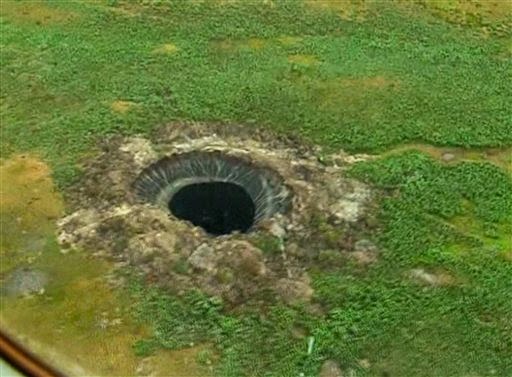
A team of Russian researchers who visited the site of one of the mysterious holes that have appeared in the ground in parts of Siberia is theorizing that the likely cause is methane buildup and release, the journal Nature is reporting.
Last month reindeer herders in the Yamal Peninsula in Siberia came across a mysterious hole in the ground—after reporting what they’d discovered, a helicopter was dispatched and personnel aboard took snapshots of what was found. The photos have since gone viral on the Internet generating speculation about what caused the hole to come about—some suggested it was nothing more than a meteor crater or sinkhole, others seemed convinced it was part of an alien invasion, while others yet postulated that it was probably the remains of a collapsed pingo (a mound of earth covered ice). Now, after visiting the site of the first hole discovered, a team of researchers has concluded that the hole, and others like it that have been spotted, are most likely due to a sudden release of methane as permafrost melts. They note Siberia has experienced extremely warm summers the past two years.
After sending a sensor down into the hole the researchers found an unusually high concentration of methane—9.6 percent, as compared to the normal 0.000179 percent. That finding and the fact that mounds of dirt near the mouth of hole indicate a blast of some sort occurred, has the researchers convinced that the warm summers caused permafrost melting which released underground methane. Gas pressure, they believe, built up to a tipping point, then was suddenly released, pushing out the material that had been sitting on top of it. Oddly, the depth of the hole is still not known. The researchers lowered a camera, but the line used was not long enough to allow for reaching the water (likely from melting permafrost) at the bottom. They estimate the depth to the water is approximately 70 meters. They would not even venture a guess as to the depth of the hole below the water.
The researchers plan a return visit to the hole to conduct more research but aren’t confident of what they will find—they note that the walls are already collapsing and water movement can be heard, suggesting that whatever evidence exists now, might be gone by the time they return.
More information:
Mysterious Siberian crater attributed to methane, Nature, DOI: 10.1038/nature.2014.15649
Note : The above story is based on materials provided by © 2014 Phys.org










